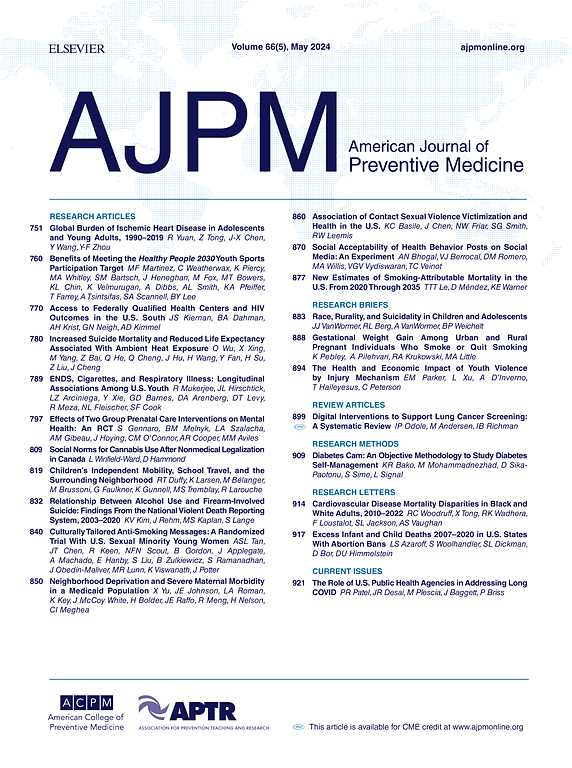Trends in Mortality Rates for Cardiovascular Disease Subtypes Among Adults, 2010–2023
IF 4.5
2区 医学
Q1 MEDICINE, GENERAL & INTERNAL
引用次数: 0
Abstract
Introduction
Cardiovascular disease mortality rates, which had been declining in the decade before the COVID-19 pandemic, increased in 2020 and remained elevated through 2022. Understanding whether trends in mortality rates from 2010 to 2023 varied by cardiovascular disease subtypes could help focus prevention and clinical management.
Methods
Annual age-standardized mortality rates per 100,000 for U.S. adults were calculated in 2025 using National Vital Statistics System death counts from 2010 to 2023. Deaths with cardiovascular disease listed as the underlying cause of death were classified into 8 major cardiovascular disease subtypes. Temporal trends from 2010 to 2023 were evaluated using average annual percentage change.
Results
In 2023, age-standardized mortality rates for cardiovascular disease subtypes were highest for ischemic heart disease (117.9 deaths per 100,000), followed by hypertensive disease (111.2), heart failure (82.1), cerebrovascular disease (65.7), arrhythmia (48.4), valvular heart disease (13.0), pulmonary heart disease (11.9), and cardiomyopathy (9.4). From 2010 to 2023, age-standardized mortality rates significantly declined for ischemic heart disease (average annual percentage change= −2.21) and cardiomyopathy (average annual percentage change= −3.00) and increased for hypertensive disease (average annual percentage change=2.52), arrhythmia (average annual percentage change=1.14), and pulmonary heart disease (average annual percentage change=1.38). Although the overall trend was not significant, age-standardized mortality rates were higher in 2023 than in 2010 for heart failure and lower for cerebrovascular disease and valvular heart disease.
Conclusions
From 2010 to 2023, mortality rates improved for ischemic heart disease and cardiomyopathy but worsened for hypertensive disease, arrhythmia, and pulmonary heart disease. These results signal a need to focus prevention and clinical management efforts to target the growing burden of cardiovascular disease subtypes.
2010-2023年成人心血管疾病亚型死亡率趋势
导语:在2019冠状病毒病大流行前的十年里,心血管疾病(CVD)死亡率一直在下降,但在2020年有所上升,并在2022年保持在高位。了解2010年至2023年的死亡率趋势是否因心血管疾病亚型而异,有助于重点预防和临床管理。方法:使用美国国家生命统计系统2010年至2023年的死亡计数,计算2025年每10万美国成年人的年年龄标准化死亡率(ASMR)。将心血管疾病列为潜在死因的死亡分为8种主要的心血管疾病亚型。利用平均年变化百分比(AAPC)评价了2010 - 2023年的时间趋势。结果:2023年,CVD亚型的ASMR最高的是缺血性心脏病(每10万人死亡117.9例),其次是高血压(111.2例)、心力衰竭(82.1例)、脑血管疾病(65.7例)、心律失常(48.4例)、瓣膜性心脏病(13.0例)、肺心病(11.9例)和心肌病(9.4例)。从2010年到2023年,缺血性心脏病(AAPC: -2.21)和心肌病(AAPC: -3.00)的死亡率显著下降,高血压疾病(AAPC: 2.52)、心律失常(AAPC: 1.14)和肺心病(AAPC: 1.38)的死亡率上升。尽管总体趋势不显著,但2023年心力衰竭的ASMR高于2010年,脑血管疾病和瓣膜性心脏病的ASMR低于2010年。结论:从2010年到2023年,缺血性心脏病和心肌病的死亡率有所改善,而高血压疾病、心律失常和肺源性心脏病的死亡率则有所恶化。这些结果表明,需要将预防和临床管理工作的重点放在主要死亡原因日益增加的负担上。
本文章由计算机程序翻译,如有差异,请以英文原文为准。
求助全文
约1分钟内获得全文
求助全文
来源期刊

American Journal of Preventive Medicine
医学-公共卫生、环境卫生与职业卫生
CiteScore
8.60
自引率
1.80%
发文量
395
审稿时长
32 days
期刊介绍:
The American Journal of Preventive Medicine is the official journal of the American College of Preventive Medicine and the Association for Prevention Teaching and Research. It publishes articles in the areas of prevention research, teaching, practice and policy. Original research is published on interventions aimed at the prevention of chronic and acute disease and the promotion of individual and community health.
Of particular emphasis are papers that address the primary and secondary prevention of important clinical, behavioral and public health issues such as injury and violence, infectious disease, women''s health, smoking, sedentary behaviors and physical activity, nutrition, diabetes, obesity, and substance use disorders. Papers also address educational initiatives aimed at improving the ability of health professionals to provide effective clinical prevention and public health services. Papers on health services research pertinent to prevention and public health are also published. The journal also publishes official policy statements from the two co-sponsoring organizations, review articles, media reviews, and editorials. Finally, the journal periodically publishes supplements and special theme issues devoted to areas of current interest to the prevention community.
 求助内容:
求助内容: 应助结果提醒方式:
应助结果提醒方式:


